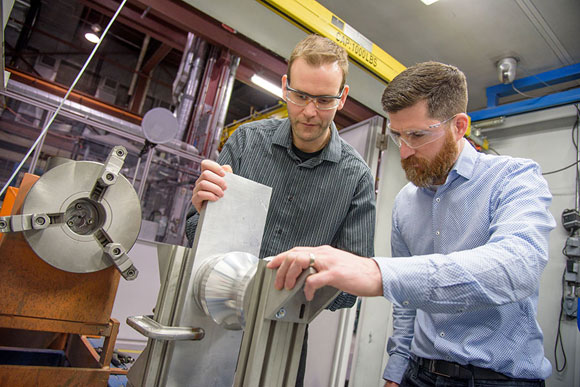Last year, we learned that Jean-Michel Lamarre and Fabrice Bernier of the National Research Council (NRC) of Canada had started fabricating electric motor magnets using a process called cold spray additive manufacturing, or CSAM. The technology involves a metal material, in fine powder form, being accelerated in a high-velocity compressed gas jet. A stream of powder hits the substrate at high speed and starts building up a layer at a time, and the process has extremely high buildup rates, which makes it possible to produce several kilograms of magnets an hour. Cold spray itself is a relatively old technology but adapted here to build up objects and giving them magnetic properties is a step forward. In many 3D printing processes, magnetic parts are problematic because we have difficulty aligning metal fibers, organizing particles or getting the part itself made.
As metal 3D printing continues to be used in more sectors of the economy in Canada, it seems that more industrial-scale demonstrations are required so that interested parties can see its potential. So now, NRC Canada and Quebec-based Polycontrols, which specializes in surface engineering solutions and equipment integration, are partnering up to improve the accessibility of CSAM for the country’s manufacturers.
Together, the two will be building a collaborative research facility, located at the NRC’s Boucherville site in Quebec, that will work to scale up the CSAM process, as well as help researchers and manufacturers study, adopt, and deploy the technology.
“The National Research Council of Canada acknowledges the value and importance this collaboration can offer the industry and the Canadian advanced manufacturing ecosystem,” said François Cordeau, the Vice President of Transportation and Manufacturing for NRC Canada. “We see great potential in bringing together different stakeholders to enable innovation and to build a network of industrial partners for a stronger Canadian supply and value chain. Our renowned technological expertise and capabilities in additive manufacturing research and development will support Poly/CSAM and contribute to developing demonstration platforms targeted at end user-industries and cluster networks.”
The Poly/CSAM facility is expected to open in February of 2020, and will help adapt laboratory-developed technology in order to meet factory and mass production requirements. Investissement Québec, the Business Development Bank of Canada, and Bank of Montreal have helped Polycontrols launch the first phase of this strategic growth initiative with an estimated $4 million investment over the six-year venture.
“Polycontrols is eager to leverage its proven track record in thermal and cold spray implementation (aerospace and surface transportation industries) to showcase its capabilities as a large-scale manufacturing integrator offering custom equipment platforms with the objective of bringing disruptive technologies such as hybrid robotic manufacturing, data analytics and machine learning (supported by Artificial Intelligence) to the shop floor,” stated Luc Pouliot, the Vice President of Operations for Polycontrols. “We see Poly/CSAM as a way to strengthen Canada’s industrial leadership in cold spray additive manufacturing and becoming more agile and competitive on the national and international scene.”
The Poly/CSAM facility will offer multiple technologies, including:
- data logging and analytics
- machine learning
- surface preparation
- sensor technologies
- in-situ robotic machining and surface finishing
- coating and 3D buildup by cold spray
- local, laser-based thermal treatment
In addition, to ensure that the technology will be used safely and securely out in the world, NRC Canada will provide advice, training, and technical services to manufacturers through its professional team of over 40 experts.
Discuss this story and other 3D printing topics at 3DPrintBoard.com or share your thoughts in the Facebook comments below.
[Source/Images: National Research Council of Canada]